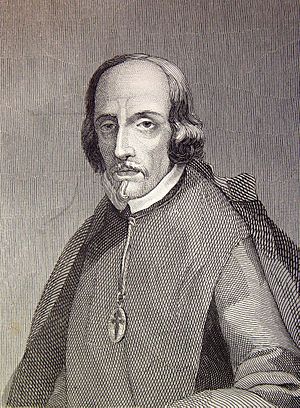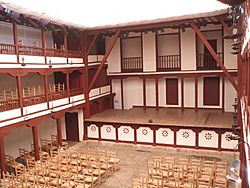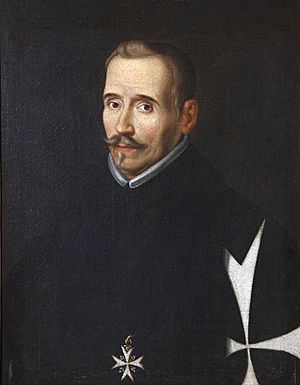Spanish Golden Age theatre facts for kids

Spanish Golden Age theatre means the plays and performances that happened in Spain from about 1590 to 1681. During this time, Spain became a powerful country in Europe. This was after the marriage of Ferdinand II of Aragon and Isabella I of Castile in 1469, and the end of the Granada War in 1492. The 1500s and 1600s saw a huge increase in live theatre. Art became very important in Spanish society.
Contents
What was Spanish Golden Age Theatre Like?
Theatre was something everyone could enjoy in Spain during the Renaissance. Rich people often paid for plays, and many people from all walks of life went to see them. Spain produced more plays during this "Golden Age" than any other country at the time. This was even more than in England!
Some people have said that Spain focused on quantity over quality. But many of the plays from this period (between 10,000 and 30,000!) are still seen as amazing works today. This huge number of plays made theatre easy for everyone to access. For people who study theatre today, it can be hard to research this period. Many plays have not been performed or studied much since the 1600s.
Different Kinds of Plays
Spanish theatre in the Renaissance was known for being very diverse. It was the only place in Europe that had both religious and non-religious plays at the same time. Plays supported by the government also existed happily alongside popular plays that made money. Many theatre artists worked on both types. Plays ranged from regular dramas to operas and sad tragedies. Spain also created its own play styles, like the Comedia nueva and the zarzuela.
Religious Plays
The most common religious plays were about the lives of saints. These were called comedias de santos. Playwrights often based their stories on old books. Other plays were based on the Bible or taught lessons from the church.
- Autos sacramentales were special plays that celebrated the mystery of the Eucharist. They mixed human characters, supernatural beings, and symbolic figures.
- These plays were performed on two or four carros (two-story wagons). They were part of parades in cities like Madrid for the Corpus Christi celebrations.
- Trade groups first produced them, but later city governments paid a lot of money for them.
- From the 1550s, professional acting groups performed them. They combined city and church authority.
- Sometimes, a special introduction called a Loa came before Autos Sacramentales. Each Loa was made for that specific play and audience. It was meant to make the audience excited to see the play. The word Loa means to give a compliment and gain good feelings.
Public Theatre

Professional public theatres started in Spain's big cities in the 1570s. The Corral de la Cruz, built in 1579, was Madrid's first permanent theatre.
- Corrales de comedias grew from performances in courtyards. They were built in rectangular courtyards with buildings on three sides. The stage was raised, and there was a standing area for people.
- Alojerias were places to buy snacks and drinks. Above them were galleries for more viewers. These included cazuelas (for women) and aposentos (box seats). Audiences were often lively and sometimes noisy.
- Corrales were first given licenses to charity groups. These groups used the money from performances to help hospitals and the poor.
Theatre at Court
Plays at the royal court became popular in the 1600s, during King Philip III's rule (1598–1621). These plays were often held at Alcazar, the royal palace.
- In 1633, a new palace called Buen Retiro became the main place for court entertainment.
- In 1640, Italian set designers helped build the Coliseo, a permanent outdoor theatre there.
- Cosimo Lotti (1571–1643) designed special effects. He created a stage over lake waters with a silver chariot pulled by two large fish. He also made a mountain change into a palace in Calderón's play Love, the Greatest Enchantment (1635).
Main Ideas in Plays
Honor was a very important theme in Spanish Golden Age plays. Theatre was used to show what life was like. Honor was shown in many ways, like a person's good name. It was often compared to disappointment and pretending. Right versus wrong was also a common theme. Lope de Vega believed that everyone cared about honor.
Good (Christian) behavior was expected by the public. To lose your honor meant living in shame. Many plots focused on the fear of losing one's good name. Men's honor was often linked to women's purity. While women seemed to control men's honor, gender roles were not changed much. Even though poverty was common, plays showed beautiful scenes, grand churches, and royal courts. Playwrights also added some humor. The funny character called the gracioso (a clown who sees things clearly) often survived stories without worrying about right or wrong.
Famous Playwrights

- Lope de Vega (1562–1635) was one of the most important writers of the Spanish Golden Age. He is second only to Miguel de Cervantes in Spanish literature. He wrote an amazing number of plays, between 800 and 1800! This makes him one of the most productive writers ever. His most famous play is Fuenteovejuna (1613).
- Calderón de la Barca (1600–1681) was also a soldier and a Catholic priest for some time. He continued to develop theatre after Lope de Vega. His work is seen as the peak of Spanish Baroque theatre. He is one of Spain's top playwrights and one of the best in world literature. One of his most famous plays is Life is a Dream (1629–1635). He also wrote about 80 Autos Sacramentales.
- Lope de Rueda (1510–1565) was a very skilled writer. He wrote dramas, comedies, and short funny plays called pasos. He helped set the stage for the Golden Age of Spanish literature. Before him, writers mostly wrote for the court. But he used his funny humor and knowledge of everyday life to make people enjoy theatre.
- Sor Juana Inés de la Cruz (1651–1695) was an important female Mexican writer, poet, and nun. She taught herself many things. She lived in colonial Mexico when Spain ruled it. She is seen as both a Mexican and Spanish Golden Age writer. One of her notable works is Loa to the Divine Narcissus. She is also on the 200 pesos bill in Mexico.
- Juan del Encina (1468–1529 or 1530) is often called the Founder of Spanish Drama. His important work is Cancionero (1496), a collection of poems and plays.
- Gil Vicente (1465–1536) was a Portuguese playwright and poet. He acted in and directed his own plays. He wrote in both Portuguese and Spanish. He is considered, along with Juan del Encina, a co-founder of Spanish drama.
- Tirso de Molina (1579–1648) was a Baroque writer, poet, and Catholic monk. He wrote about 400 plays, and 80 of them still exist. One of his most famous plays is El Burlador de Sevilla y convidado de piedra (The Trickster of Seville and the Stone Guest). This play was the first to show the character of Don Juan.
- Francisco de Rojas Zorrilla (1607–1648) had many of his plays adapted in other countries. His main works are Del rey abajo ninguno and No hay padre siendo rey, both published in the 1640s.
- Juan Ruiz de Alarcón (c. 1581–1639) was known for the consistent quality of his work.
Actors and Theatre Groups
After 1603, only theatre groups with a special license could perform in Spain. These licenses were hard to get. Actors without licenses joined "companies of the road" (compañías de la legua). They performed in the countryside. Theatre groups could not perform in one place for more than two months a year. Only one group was allowed to perform at that spot.
In 1615, Madrid's government took control. They hired groups made up of actor-managers (autores), actors, and apprentices. These groups had to follow government rules. The Royal Council gave them licenses. They were paid well to perform Autos Sacramentales both at court and in public theatres. Actors usually worked for managers under a 1 to 2-year contract. A typical day for an actor involved studying their role from 2 AM to 9 AM. They rehearsed until noon, took a break, and then performed until 7 PM.
Women were allowed to perform starting in 1587. But this was a debated topic until 1599. A royal rule then said that only women married to members of the theatre group could perform. Important performers included Lope de Rueda and later Juan Rana.
Costumes
Costumes during this time were much like those in Elizabethan or English Renaissance theatre. Actors dressed as grandly as they could afford. Contracts even had special money set aside for costumes. Records show that actors paid about 1/5 to 1/2 of their salary for one costume! Some even asked city officials for extra money for costumes. Towns gave awards for acting and costumes. This shows that the quality of costumes was very important to the audience.
The government made many rules about costumes. For example, actors in Auto Sacramentales had to wear silk or velvet. Women were not allowed to wear strange hats, low necklines, or wide or short skirts. Also, actors could only wear one costume per play, unless the play specifically said otherwise.
Stage Design
Three main types of scenic backgrounds were used. These included the front of the stage, curtains that hid the front (used when the location wasn't important), and medieval-style "mansions." These "mansions" were sometimes built on the main stage. After 1650, as shows became grander, painted flat pieces with doors and windows were put into the stage front instead of curtains.
Over time, awnings were put over the audience seats. Eventually, a permanent roof was added, making it an indoor theatre. In the 1640s and 1650s, Italian designers oversaw the set designs for new public and court theatres. Machines that made wind sounds and thunder (using metal sheets or dropping wood planks) were common. Machines that made rain (like a big rainstick) and ocean waves also delighted theatregoers. Musicians were often used to create moods and important sound effects.
Why it was Important
Spain had unique theatre traditions, unlike the rest of Europe. Religious plays continued to be popular into the 1700s. Religious and non-religious theatre thrived side by side. Actors were accepted in the church and as valuable members of society. Spain also led the way with a three-act model for plays instead of the usual five acts. Women were allowed on stage. There was an organized system for actor contracts, travel money, licenses, and booking shows.
Most importantly, Spanish Golden Age theatre produced wonderful plays that used stories to talk about politics and ideas. Examples include Calderón's Life is a Dream and Lope de Vega's Fuente Ovejuna. These plays spoke directly to the people of that time.
The new national theatre of Spain got its ideas from many places. Storytelling from Italian Commedia dell'arte and Spanish traveling performers influenced the stories and music. Ideas from ancient Greek theatre and church plays also added literary and moral viewpoints. In turn, Spanish Golden Age theatre greatly influenced plays in Europe and around the world later on. It had a big impact on English Renaissance theatre. It also had a lasting effect on theatre in all Spanish-speaking countries. Today, more and more of these works are being translated. This helps more people discover Spanish Golden Age theatre and appreciate its importance.
See also
 In Spanish: Teatro español del Siglo de Oro para niños
In Spanish: Teatro español del Siglo de Oro para niños
- English Renaissance theatre
- History of theatre
- Spanish Golden Age
- Revenge play
- Cloak and dagger play

